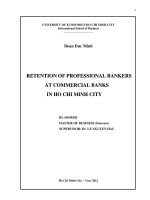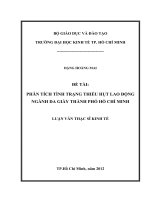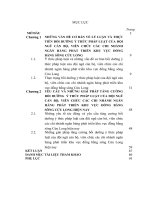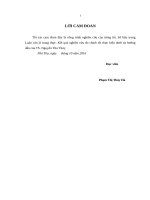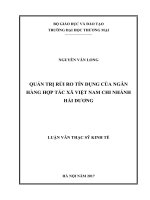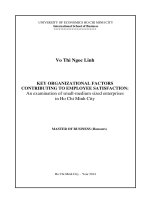(Luận văn thạc sĩ) factors influencing customer retention some emprical evidences from local and foreign banks in ho chi minh city
Bạn đang xem bản rút gọn của tài liệu. Xem và tải ngay bản đầy đủ của tài liệu tại đây (1.13 MB, 84 trang )
UNIVERSITY OF ECONOMICS HO CHI MINH CITY
International School of Business
------------------------------
Nguyen Quang Minh
Factors Influencing Customer Retention
Some Empirical Evidences from Local and Foreign
Banks in Ho Chi Minh City
MASTER OF BUSINESS (Honours)
Ho Chi Minh City – Year 2015
UNIVERSITY OF ECONOMICS HO CHI MINH CITY
International School of Business
------------------------------
Nguyen Quang Minh
Factors Influencing Customer Retention
Some Empirical Evidences from Local and Foreign
Banks in Ho Chi Minh City
ID: 22130039
MASTER OF BUSINESS (Honours)
SUPERVISOR: DR. LE NGUYEN HAU
Ho Chi Minh City – Year 2015
TABLE OF CONTENTS
ABSTRACT
1. INTRODUCTION ............................................................................................... 1
1.1. Research background .................................................................................... 1
1.2. Research questions and research objective ................................................... 3
1.3. Research delimitation. .................................................................................. 3
1.4. Thesis Structure. ........................................................................................... 3
2. LITERATURE REVIEW ................................................................................. 5
2.1. Theoretical review ......................................................................................... 5
2.1.1. Customers retention ............................................................................ 5
2.1.2. Relationship quality. ........................................................................... 7
2.1.3. Switching barriers. .............................................................................. 9
2.1.3.1 Relational benefits .................................................................. 9
2.1.3.2 Switching costs ..................................................................... 10
2.1.3.3 Availability and attractiveness of alternatives ..................... 10
2.2. Hypotheses Development. ........................................................................... 11
2.2.1. Customer satisfaction and customer retention.................................. 11
2.2.2. Trust and customer retention ............................................................ 13
2.2.3. Commitment and customer retention ............................................... 14
2.2.4. Switching barriers and customer retention ....................................... 16
2.3. Research Model ........................................................................................... 18
3. METHODOLOGY .......................................................................................... 21
3.1. Research design ........................................................................................... 21
3.2. Measurement scales ..................................................................................... 22
3.3. Method of data collection. ........................................................................... 24
3.3.1. Sample size. ...................................................................................... 24
3.3.2. Method of data collection. ................................................................ 25
3.4. Data analysis method................................................................................... 26
3.4.1. Assessment of measurement of scale. ................................................. 26
3.4.2. Multiple Regressions. .......................................................................... 27
4. DATA ANALYSIS AND RESULT ................................................................. 28
4.1 Sample characteristics ................................................................................... 28
4.2 Assessment of measurement scales .............................................................. 29
4.2.1 Cronbach Alpha .................................................................................. 29
4.2.2 Exploratory factor analysis................................................................. 32
4.2.2.1 EFA for independent factors .................................................. 32
4.2.2.2 EFA for dependent factors ..................................................... 34
4.3 Hypothesis testing ......................................................................................... 35
4.3.1 Testing relationship of independent factors & dependent factor ....... 35
4.3.2 Testing Assumption of multiple Regressions .................................... 37
4.3.3 Evaluate and test the relevance of the model ..................................... 41
4.4 Comparing foreign banks and local banks .................................................... 43
5. IMPLICATION AND CONCLUSION ............................................................ 46
5.1 Summary ....................................................................................................... 46
5.2 Conclusion .................................................................................................... 47
5.3 Recommendation .......................................................................................... 49
5.4Limitation and further research directions ..................................................... 51
APPENDIX 1: EFA RESULT FOR FIRST TIME RUNNING............................... 73
APPENDIX 2: EFA RESULT FOR SECOND TIME RUNNING ......................... 74
APPENDIX 3: KMO & BARTLETT‟S TEST FOR THIRD TIME RUNNING .... 75
APPENDIX 4: EFA FOR INDEPENDENT FACTOR ........................................... 76
APPENDIX 5: MULTIPLE REGRESSION ............................................................ 77
LIST OF FIGURES
Figure 1: Research model ......................................................................................... 19
Figure 2: Research process ....................................................................................... 21
Figure 3: Revised research model ............................................................................ 37
LIST OF TABLES
Table 3.1: Summary of scales for 9 constructs in the model ................................... 23
Table 4.1: Sample characteristic............................................................................... 28
Table 4.2: Reliability Analysis ................................................................................. 30
Table 4.3: Revised Reliability Analysis ................................................................... 32
Table 4.4: EFA result for independent factors ......................................................... 33
Table 4.5: EFA result for dependent factor .............................................................. 35
Table 4.6: Result of Pearson Correlation ................................................................. 35
Table 4.7: Hypothesis testing result ......................................................................... 38
Table 4.8: Multiple Regressions results of Customer retention to independent ...... 41
Table 4.9: Conclusion ............................................................................................... 42
Table 4.10: Comparing factors between local banks and foreign banks .................. 44
Table 4.11: Relationship between Respondents‟ Likelihood of Staying and Bank . 45
ABSTRACT
Customer retention is an important element of any banking strategy in today‟s
increasingly competitive environment. To achieve the customer retention strategy,
some elements are examined. Among of them are relationship quality and switching
barriers. Relationship quality is often seen as the key factor for business building a
successful and long-term relationship. In the context of high competitive market
place nowadays, relationship quality is often viewed as a central determinant of
customer retention. However, the few empirical investigations in this area indicate
that relationship quality is only a necessary condition, not enough to keep customer
stay with the business. One more factor is given to discuss in this study is switching
barriers. Together with relationship quality, we explore how switching barriers help
the services suppliers keep their existing customers from changing to another
competitor.
This research examined these factors in the context of banking industry in Vietnam,
a developing country with penetration of many foreign banks through the process of
integrate WTO. Customers nowadays have many options to choose which bank they
want to cooperate. Therefore, both foreign banks and local banks have to develop
their strategies to retain their customers and increase their advantages.
1
CHAPTER 1: INTRODUCTION
This chapter provides a background of information on the present study and
its objectives and purposes. It is divided into four sections. The first section presents
background of the research, the second part presents the problem statement and its
objectives, and the third part presents the scope of study and the final part present
the thesis structure.
1.1 Research Background
In today‟s highly competitive environment, losing customer is very costly.
Researcher concluded that it can be ten times more expensive to attract a customer
than to retain an existing one, and the cost of bringing new customer to the level of
profitability as the lost one is up to 16 times more (Lindgreen et al., 2000).
Understanding thoroughly these difficulties, companies are more focusing their
strategic effort on customer retention (Berry, 1983; Fornell, 1992). Many studies
have been conducted for this issue, and many opinions have been explored for which
factors influencing customer retention. Obviously, a key component in any customer
retention program is relationship quality (Oliver, 1997). Relationship quality can be
defined as customers‟ perception of how well the relationship responds to his/her
expectations, aims and demands (Jarvelin & Lehtinen, 1996). From that, they would
consider about continuing or terminating with current suppliers. There are many
factors that constitute relationship quality. After reviewing the empirical and
theoretical literatures, we identified three elements which are commonly claimed to
represent as significant components of perceived relationship quality: customer
satisfaction (Hendrick, 1988), trust (Rempel, Holmes & Zanna, 1985) and
commitment (Adams & Jones, 1997; Lund, 1985).
However, for the purpose of keeping customer staying with business longer,
the management need to consider other factors helping them to achieve that
2
objective. In recent studies, switching barriers is a significant element should be
mentioned. Follow Jones et al (2000) switching barriers is any factor that makes it
difficult or costly for customers to change supplier. Thus, if company desires to
develop long-lasting relationships with their customers, it is important for them to
understand why dissatisfied customers may or may not switch to other suppliers and
how the presence of switching barriers can affect the evaluation of service recovery
effort (Yanamandram & White, 2006). In case, businesses know which dimensions
are important to customer‟s decision about switching to competitors they can tailor
their products to respond more specifically to customer needs. Responding
appropriately to customer needs mean that company is likely to retain more
customers and build brand loyalty amongst existing customers. Therefore, in an
effort to preclude switching and harden long-term working relationships, business
suppliers nowadays find many methods to make customers feel satisfied, reinforce
their trust and commitment in customers‟ perception and strengthen exit barriers to
effectively retain buyers. This research is to identify the interaction effects of
relationship quality and switching barriers to customers‟ awareness and decision.
We test our model in a continuous purchasing setting, the banking sector.
Banking industry is a modern services industry. Especially, becoming a membership
of World Trade Organization (WTO) requests Vietnam opening out to foreign
investors as their liberalization requirements (Nguyen, 2008). Therefore, the number
of foreign-owned financial institutions has been steadily increased. Until now,
foreign banks have been growth to 49 branches, which mostly concentrated in Ho
Chi Minh city and Hanoi. This is an impression number compared with 2007, the
year Vietnam joined WTO, were 5 foreign owned banks. In this highly competitive
banking market, foreign banks, however, are at an advantage in comparison with
their Vietnamese counterparts. They have better organizational structures, offer
more professional services, and enjoy the network across many countries. On the
3
other hand, local banks also have their own specific strength such as widespread
braches, familiar with Vietnamese, and support from State Bank. With more and
more diversified customer‟s demand nowadays, banks have to renew themselves and
find more effective solutions to attract new customers as well as retain the current
ones. That makes the competition between the local banks and foreign banks
become more fierce and intensive to stand firm in competitive marker-place.
Researching about above factors and how they affect to customer retention greatly
contributes to bank‟s strategy.
1.2 Research question and research objective
The objective of this study isto identify the effect of relationship quality and
switching barriers on customer retention. Particularly:
- How many factors constituting relationship quality? How does each of them
affect customer retention?
- How many factors constituting switching barriers? How does each of them
affect customer retention?
- Which factor will influence customer retention most?
1.3 Research delimitation
This study focuses on retail customers at local banks and foreign banks in Ho
Chi Minh City. The candidates for this research usually use banking services on
routine life. Young people under 18 years old who do not have much income and
can not make individual financial decisions are not chosen to be respondent. Hence,
this sample can not represent for Vietnam nationwide. Furthermore, there are four
factors including satisfaction, trust, commitment, and switching barriers being
explored.
1.4 Thesis structure
This thesis is organized as follows:
4
-
Chapter 1 introduces the background view, research problems, research
objectives, research question, research delimitation and thesis structure.
-
Chapter 2 introduces research model and its hypotheses as well as its
literature review.
-
Chapter 3 illustrates the methodology conducted in this paper.
-
Chapter 4 presents research results is based on data collected.
-
Chapter 5 summarizes the research result, provide the findings, limitation and
recommendations.
5
CHAPTER 2: LITERATURE REVIEW
In this chapter, theoretical background and review on previous studies are
presented. This chapter includes three sections. The first section is theoretical review
relating to relationship quality and switching barriers and customer retention. The
second describes the hypothesis development among them for this research. The last
section presents research model.
2.1. Theoretical review
2.1.1 Customer retention
Several explanations have been offered in previous studies for customer
retention. According to Jones et al (2000), customer‟s retention is an activity that
selling organization undertakes in order to reduce customer defection. It is a result of
a kind repetitive behaviour ultimately aims at achieving customer loyalty (Liu &
Wu, 2007). Customer retention can be viewed as a measurement of relationship
continuation also. It is a significant area of study in the field of relationship
marketing that is mainly concern with keeping customers in the long term
(Gronroos, 1997). Therefore, customer retention is potentially an effective tool that
business can use to gain a strategic advantage and survive in today‟s highly
competitive market place (Thomas, 2001; Clayton-Smith, 1996; Dawkins &
Reichheld, 1996).
Many studies insist on the benefits of customer retention in improving firm
value (Hidalgo et al., 2008). Keeping the customer has become as well as, if not
more important, than creating a new customer. It is gradually recognized that
customer can be managed overtime as they have a life-cycle from acquirement,
retaining and can be grown in value (Ang & Buttle, 2006). Successful customer
retention begins with the first contract an organization has with customer and
continues throughout the entire timeline of a relationship. In addition, the longer
6
term customers buy more and, if satisfied, may generate positive word-of-mouth
promotion for the company. Besides the benefits that the longevity of customers
brings, research finding also explores that the cost for customer retention activities
are less than the cost of acquiring new customers. It can be five times as costly as
keeping existing customers like Rust and Zahorik‟s research (1993), or even ten
times costly like Lindgreen‟s research (2000). Obviously, this cost is higher with
every passing day. Most business declares that creating and maintaining customer
relationships are important to them and they are aware of the positive values that
relationship provides (Colgate et al., 1996). With each additional year of relationship
between the supplier and customer, the customer becomes less costly to serve
because of learning effects and decreased serving costs (Reichheld & Sasser, 1990;
Turnbull, 1990). The replacement costs will fall also since fewer customers churn.
From there, the stability of income and expense are improved and developed. With
all above advantages, for manager to compete successfully in today‟s marketplace, it
is a key priority to develop a smart and profitable customer retention strategy to
keep their existing customers and making more profit from them (Weinstein, 2002).
The main factors influencing customer‟s selection of a bank include quality
of services, rates, fees and price charges (Abratt & Russell, 1999). Service
excellence, meeting client‟s demands, and providing innovative products are
essential to succeed in the banking industry. However, it is apparent that superior
service, alone, is insufficient to satisfy customers and make them stay with us in
long term. Some factors become important also are relationship quality and
switching barriers. Most commercial banks claim that creating and maintaining
customer relationships are significant to them and they are aware of the positive
values that relationship quality and switching barriers provided (Colgate et al.,
1996). In view of these results it comes as no surprise that service provider has to
7
increase their level of customer relationship quality and bring in more switching
barriers to retain customers.
2.1.2 Relationship quality
Over last two decades, relationship quality has become a main pillar of
customer relationship and gained in important as a measure of successful business
relationship. According to Crosby et al. (1990), relationship quality is a general
evaluation of relationship strength and the extent to which a relationship meets the
demands and expectations of the parties involved based on a history of successful or
unsuccessful cooperates or events. The concept of relationship quality also expresses
a multidimensional construct reflecting the essence of relationships between
suppliers and consumers (Hennig-Thurau & Klee, 1997; Hennig-Thurau et al., 2002)
and as a condition for long-term relationships and customer retention (Bejou et al.,
1996; Crosby et al., 1990; Hennig-Thurau, 2002; Hennig-Thurau & Klee, 1997;
Moliner et al., 2007). Amongst the dimensions which constitute the relationship
quality construct, in the antecedent studies of consumer markets research steadily
suggest the concepts of trust and satisfaction (Bejou et al., 1996; Crosby et al., 1990;
Lin & Ding, 2005). However, most of authors also consider commitment to be an
dimension of this (De Wulf et al., 2001, Hennig-Thurau, 2000; Moliner et al., 2007),
while only a few adds some other dimensions beyond the three above ones (e.g.
affective conflict in Roberts et al., 2003, or social bonds in Lang & Colgate, 2003).
As a result, we define the construct of relationship quality in the retail environment
with trust, commitment and satisfaction. All of them give the signal a long-term
orientation, and link up consumer markets (Farrelly & Quester, 2005; Garbarino &
Johnson, 1999; Lang & Colgate, 2003; Morgan & Hunt, 1994; Woo & Ennew,
2004).
8
Roberts-Lombard (2009) defines customer satisfaction as “the degree to
which a business‟s product or service performance matches up to the expectation of
the customer. If the performance matches or surpasses the expectations, then the
customer is satisfied, if performance is below par then the customer is dissatisfied”.
Follow to Salami (2005), satisfaction is a customer‟s emotional response when
evaluating the discrepancy between expectations of the service and the perception of
actual performance. This perception of performance is obtained via the physical
interaction with the products and services of the business. High levels of service and
product quality may lead to increase customer loyalty, higher profitability, increase
market share and lower customer turnover. On the contrary, a customer who is
unsatisfied with services received is not expected to have a good relationship with
the business (Roberts et al., 2003).
Trust is defined as a willingness to depend on a partner in whom one has
confidence (Moorman et al., 1993). Schurr and Ozanne (1985) defined the term as
the belief that a partner‟s word or promise is reliable and a party will fulfil his/her
obligations in the relationship. Generally, the strength and quality of a relationship
rely on the level of trust – the higher the trust level, the stronger the relationship will
be. Loyalty and trust for exchange partners in a relationship is an obligation and
rendered without anticipation of reciprocity (Yau et al., 2000). Disregarding this
obligation can seriously damage one‟s reputation and lead to many disadvantages.
Indeed, one would expect a positive outcome from a partner on whose integrity one
can rely on confidently (Morgan & Hunt, 1994).
According to Morgan and Hunt (1994), commitment rises from trust, shared
values and the belief that it will be difficult to find partners can offer the same value.
Commitment encourages both parties to cooperate aim at conserving investments in
the relationship (Morgan & Hunt, 1994). Relationships are built on the foundation of
9
mutual commitment, and the commitment level has been found to be the strongest
predictor of the voluntary decision to pursue a relationship (Ibrahim & Najjar,
2008). Parties in the relationship identify commitment as the key element to develop
and maintain their relationship. A high level of commitment brings about the context
in which both parties can gain individual and joint objectives without fear of
opportunistic behaviour.
Relationship quality has been conceded by a number of researchers as a
significant variable in the study of customer loyalty and retention. This is not to say
that loyalty does not occur in the condition of low relationship strength, however, in
such situation, the likelihood of future services encounters is more depend on
external factors such as low level of alternatives or high switching barriers.
2.1.3 Switching barriers
Switching barriers in the retail services industry include search costs,
transaction costs, learning costs, loyal customer discounts and emotional costs
(Va´zquez-Carrasco & Foxall, 2006; Pass, 2006; Pont & McQuilken, 2005;
Sengupta et al., 1997). Switching barriers also relate to perceived risk of customer,
which is defined as the buyer‟s perception of the uncertainty and untoward
consequences of buying a product or service (Dowling & Staelin, 1994). Colgate
and Lang (2001) divide switching barriers into relational benefits, switching costs,
availability and attractiveness of alternatives and service recovery. In their later
research, Va´zquez-Carrasco and Foxall (2006) used the first three switching
barriers:
1. Relational benefits.
2. Switching costs.
3. Availability and attractiveness of alternatives.
2.1.3.1. Relational benefits
10
Consumers commit themselves to creating, developing, and maintaining
relationships with company that provides higher ranking valued benefits (Liu, 2006;
Gwinner et al., 1998). Va´zquez-Carrasco and Foxall (2006) generalize relational
benefits as social benefits, confidence benefits and special treatment benefits. By
switching to another supplier, the customer would lose the benefits from the existing
relationship which not readily available from the competitors. Hence, although a
customer is dissatisfied with his or her business services the scare of losing
relational benefits makes him or her decide in favour of staying with the company
(Yanamandram & White, 2006). Ranaweera and Prabhu (2003) confirm that service
providers may be able to retain even with unsatisfied customers who perceive high
switching barriers. However, in long term, unsatisfied customer would find a way
out for their problems. So that, firms should develop a combined strategy that makes
switching barriers act as a complement to satisfaction to retain customer (Ranaweera
& Prabhu, 2003).
2.1.3.2. Switching costs
In simple terms, switching costs are costs of changing services in terms of
time, monetary and psychological costs (Jones et al., 2002; Dick & Basu, 1994;
Sengupta et al., 1997). Panther and Farquhar (2004) mentioned the trouble to change
service providers such as have no time to change or appraise another service
providers as some of the reasons why customers choose to stay with their present
services. Other examples of switching costs include the customer‟s effort needed to
inform his or her business partners about this changing. In case switching to a new
bank service provider, customer has also take time to deal with the old services
provider‟s relevant issues (e.g. in banking industry, he or she has to delay in
receiving check books and automated teller machine (ATM card), cancelling
internet banking, mobile banking and any loan or commitment with the old bank).
11
Because services are intrinsically difficult to evaluate, it has been argued that the
costs of switching tend to be higher for service providers (Gremler & Brown, 1996).
2.1.3.3 Availability and attractiveness of alternatives
Availability and attractiveness of alternatives refers to customers‟ perception
regarding the extent to which competing alternatives are available in the marketplace and how good the competing alternatives would be in comparison with current
supplier. According to Bendapudi and Berry (1997), customers might continue in
current relationship because there may be not many or any alternatives due to the
nature of the industry. Moreover, Patterson and Smith (2003) comment that
customers may perceive few alternatives in the market because of the fact that many
of the alternatives are not in their memories or simply they do not perceive the
alternatives as more attractive as the current relationship.
2.2 Hypothesis development
In this part, we construct the model about the relationship among relationship
quality and switching barriers and customer retention. How the dimensions of
relationship quality such as customer satisfaction, trust and commitment affect to
customer retention, as well as how each of switching barriers factors influence
customer retention.
2.2.1 Customer satisfaction and customer retention.
Following Magesh (2010), satisfaction means a feeling of pleasure cause one
has something or has achieved something. According to Cronin et al (2000),
customer satisfaction is an emotion state which arises in evaluating a particular
service. It also can be defined as a degree at which the standard of services meets the
customer‟s expectation.
Customer satisfaction has been long recognized in marketing theories and
practices as a core concept in business activities (Anderson & Weitz, 1992; Fornell,
1992). Marketers treat customer satisfaction as an important determinant of positive
12
word of mouth, consumer loyalty and repeat purchase intention (Kotler, Armstrong
& Cunningham, 2002). In recent publications, satisfaction has been treated as the
necessary condition for the retention of customers, and therefore has moved to the
forefront of relational marketing approaches (Rust & Zahorik, 1993). From those
opinions, we can understand that customer satisfaction and retention mutually
correlate. The higher level of satisfaction customers feel, the higher probability they
stay with the services. That is the key factor for long term business relationship
(Tsoukatos & Rand, 2006). Storbacka et al. (1994) also asserts that improved service
quality leads to improve customer satisfaction, while the latter leads to a stronger
customer relationship. The higher stage of relationship, the stronger the role of
satisfaction in eliminating other primary exchange partners providing similar
benefits (Dwyer & Oh, 1987). As a result, a customer who feels unsatisfied with the
service received is not expected to have a good relationship with the firm as well as
stay with the business longer (Roberts et al., 2003). Many authors (e.g. Andreassen
& Lindestad, 1998; Garbarino & Johnson, 1999; Guenzi & Pelloni, 2004; Lam et al.,
2004) treat customer satisfaction as a cumulative factor which means that, instead of
appraising specific evaluations and emotions at a specific moment, they focus on
consumer‟s general level of satisfaction based on all history experiences with a
particular retailer. In these terms, satisfaction really looks like to be “backward
looking”, being a function of performance from the past until current date
(Gustafsson et al., 2005).
Addition, Levy and Weizt (2009) and Storbacka et al. (1994), at a more
concrete view, define customer satisfaction in a retail environment as a postconsumption evaluation of how well a retailer with its mix of goods and services
meets or surpasses customer expectations. From that point of view, we can
understand that customer satisfaction concentrates not only on services but also
products. In highly competitive market with diversified products nowadays, banks
13
need to pass their competitors by offering high quality products and services to
make their customers feel satisfied. That is a positive foundation to build up a good
relationship with customer and keep them staying longer. In some particular cases,
current customer would create more new customers for bank by commenting good
things to others. That would be considered as a good marketing method and
increasing advantage for bank. So that, the importance of satisfaction on retention is
appropriately recognised by many huge economic on the world to predict customer‟s
behaviour and future finance performance (Fornell, 1992).
H1. There is a positive impact of customer satisfaction on customer retention.
2.2.2 Trust and customer retention.
We generalize the idea from Morgan and Hunt‟s (1994) study that
relationship can be considered as a series of transactions that bring out an awareness
of a hard relationship through trust and commitment. Higher level of trust is closely
relevant to higher probability level of customer retention.
Recent studies show that in some particular situations, service providers
cannot prevent customers from switching even with who are satisfied (Heskett et al.,
1994; Schneider & Bowen, 1999). Customer satisfaction alone can not maintain
long term relationship to a single provider. Hence, it should be looked beyond
satisfaction to other factors that reinforce customer loyalty such as trust (Hart &
Johnson, 1999). Trust is something you have to continually build, earn and renew. In
the retail environment, trust is the consumer‟s confidence in a retailer‟s reliability
and integrity (De Wulf et al., 2001, p. 36). Thomas (2009) defines trust as an
expectancy of positive results that one can get based on the expected action of
someone. Trust also describes one party‟s expectation that the other party will
behave in a certain predictable way in a given situation (Groănroos, 2007). Trust in
business comes from customers‟ positive experiences that make them to continue
with the relationship (Berry, 2000; Foster & Cadogan, 2000).
14
The marketing literature differentiates between two types of trust, namely, trust in a
partner‟s credibility and trust in a partner‟s benevolence (e.g. Doney & Cannon,
1997; Ganesan, 1994; Kumar et al., 1995). According to the definitions, the study
suggests that trust in a retailer‟s credibility applies in the context that the customer
believes that he or she can rely on the retailer‟s knowledge, and that the retailer will
perform its role in an effective and reliable way. With the concept of trust in a
partner‟s benevolence in the retailing environment it is the customer‟s perception of
the extent to which the retailer care about the customer‟s welfare (Ganesan, 1994;
Kumar et al., 1995; Roberts et al., 2003). In the financial service industry, according
to Bayne (1999) trust together with honesty, has been taken as one of the basic
customer needs. Customer trust within the retail banking services is the belief that
banks can look after their money, ensure competitive interest rates, and to effect
payments and transactions in a timely and accurate manner. It is also the belief that
their current banks care about their benefits, their demands and their expectations.
Therefore, banks have to prove that they deserve to be trusted. If a bank fails in any
of these basic duties, it will suffer damage to its reputation and brand. Once
damaged, this fail brings about many consequences such as customer switching,
losing its market share and taking a long time and a great deal of effort to repair its
reputation. According to Wirtz and Lihotzky (2003), building and developing
customer trust and loyalty are the most proper strategy for commerce-based
businesses. Customer trust significantly contributes to sales growth through
customer acquisition and retention. It is therefore hypothesised that:
H2.There is a positive impact of trust on customer retention.
2.2.3 Commitment and customer retention.
Commitment is recognized as a necessary element for successful long term
relationship (Anderson & Weitz, 1992). In general, commitment refers to an
15
orientation that specifies both parties‟ intentions and behaviours over the long term
(Farelly & Quester, 2005). Commitment is a multidimensional construct including
emotional, calculative, and normative commitment. Emotional commitment refers to
customer desire to do business with the firm they want (Allen & Meyer, 1990).
Customers uphold a relationship with business because they identify themselves
with and like the firm (Fullerton, 2005). In other words, when customers are
emotionally attached, they want the organization which they are interested in
(Fullerton, 2005). Therefore, emotional commitment refers to a customer‟s free will
to uphold the relationship with the firm with which they do business. Calculative
commitment relates to the necessary of maintaining a relationship with a supplier
(Allen & Meyer, 1990). Either customer or his/ her partner aware of losing benefits
and other interests incurred if the relationship brings to an end (Geyskens et al.,
1996). Sometimes, both parties scare of losing each other. Calculative commitment
is consequently identified as more rational, economic-based dependence, while
emotional commitment refer to more emotional factor, which develops through the
degree of reciprocity or personal involvement, that a customer has with a company
(Gustafsson et al., 2005). Normative commitment refers to the moral obligation to
stay in a relationship (Allen & Meyer, 1990).
The nature of emotional, calculative and normative commitment are different,
in term of the focus on the respect want to stay, the need to stay out of economic
investments and the need to stay out of moral obligations. It is argued that the
respect want to stay (emotional commitment) and the need to stay out of moral
obligations (normative commitment) indeed have positive impacts on customer
behaviour, therefore they have positive effect on customer retention, whereas the
need to stay out of economic investments (calculative commitment) is negatively
relevant to customer behaviour. Emotional and normative commitment can be
considered to be driven by personal considerations such as personal attachment or
16
personal ethics, while calculative commitment is rather based on a rational trade-off
of costs and benefits comparing the current supplier with potential alternatives and
the sunk costs made to establish the relationship (Meyer & Allen, 1984). However,
in the context of keeping customer, calculative commitment still has positive impact
on retention. It contributes on making some difficulties to customer in changing
suppliers. In banking sector, the effect of commitment, emotional, calculative and
normative commitment, are important. Customer‟s attitudes are diversified. They
can choose to maintain relationship with bank based on emotional commitment or
calculative commitment or normative commitment. It depends on their perception
which kind of commitment gives more benefit for them. Or in different period,
customer has different decision based on their given status.
H3. There is a positive impact of emotional commitment on customer retention.
H4. There is a positive impact of calculative commitment on customer retention.
H5. There is a positive impact of normative commitment on customer retention.
2.2.4 Switching barriers and customer retention.
Switching barriers represent any factors, which make it more difficult or
costly for consumers to change providers. Switching barriers in customer‟s
perception can be define as consumer‟s assessment of the resources and
opportunities needed to perform the switching act, or alternatively, the constraints
that prevent the switching act (Bansal & Taylor, 1999). Keaveney‟s (1995) study
was one of the first to prove switching barriers as a determining factor of customer
switching behaviour. Later on, Gremler and Brown (1996) used in-depth interviews
to construct a model that included switching costs as a prerequisite factor of
customer loyalty and customer retention. They defined switching costs as the
investment of time, money and attempt that, in customers‟ perception, made it more
difficult to switch. Among the examples of switching costs they listed were habit,
inertia, set up, search, learning, contractual and continuity costs.
17
Switching barriers in the banking industry include search cost, transaction
costs, learning cost, loyal customer discounts and emotion costs (Vazques-Carrasco
& Foxall, 2006; Pass, 2006; Pont & McQuilken, 2005; Senguptaetal., 1997).
Julander and Soderberg (2003) stated that switching barriers could be considered as
both positive and negative. Hirschman (1970) indicated that the positive aspect of
switching barriers is relevant to “wanting to be in a relationship” while negative
aspect is relevant to “having to be in a relationship”.
In term of the positive or more reward-based type of switching barriers, firms
could encourage the interpersonal relationship between customers and providers to
keep them stay (Berry & Parasuraman, 1991). This kind of relationship offers many
relational benefits to customers such as social, economic and customization.
Empirical study shows that customers want to commit with the suppliers that
provide them better value benefits and efficient switching barriers (Colgate &
Danaher, 2000).
H6. There is a positive impact of relational benefits on customer retention.
Regarding to negative or punitive type of switching barriers, firms could use
switching costs and lack of existing attractive alternatives to retain their clients.
Switching costs are customer‟s perception of time, money, and effort they have to
give in when changing services supplier (Jackson, 1985; Jones et al., 2000). Some
studies have examined the relationship between switching costs and customer
retention (Burnham et al., 2003; Grace & O‟Cass, 2003; Jones et al., 2000; Nielson,
1996; Ping, 1993) and some studies conclude that switching costs are one of the
significant reasons why dissatisfied customers do not changed their provider.
Therefore, switching costs has positive effect on customer retention, although its
nature is to force customer staying with current supplier. It is also an element to
explore when we examine customer retention.
18
H7. There is a positive impact of switching cost on customer retention.
Attractive alternatives refer to customer‟s perception about available
suppliers in the market place (Jones et al., 2000). The existence of alternatives is
also a key factor for switching. When viable alternatives are lacking, the possibility
customers exiting their current relationship also decrease (Sharma & Patterson,
2000). On the contrary, when customers perceive the existing of attractive
alternatives, they refer to switch (Sharma & Patterson, 2000). Thus, if dissatisfied
customers are unaware about the existence of other alternatives, they are more likely
to stay in the relationship.
H8. There is a negative impact of availability and attractiveness of alternatives on
customer retention.
In summary, no matter switching barriers affects the relationship in positive
or negative way, they decrease customer‟s leaving intention and increase the
quantity of customer stay with the business.
2.3 Research Model.

